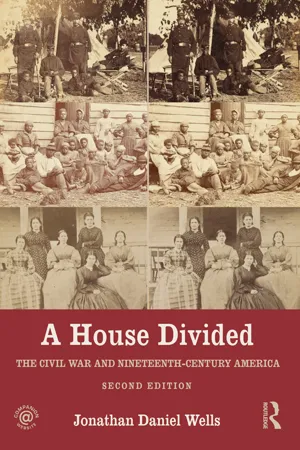History
Compromise of 1877
The Compromise of 1877 was a political agreement that effectively ended the Reconstruction era in the United States. It involved the withdrawal of federal troops from the South, effectively ending Reconstruction, and the appointment of a Southern Democrat to the president's cabinet. In exchange, the Republicans gained support for Rutherford B. Hayes as president. This compromise marked the beginning of the Jim Crow era in the South.
Written by Perlego with AI-assistance
Related key terms
2 Key excerpts on "Compromise of 1877"
- eBook - ePub
A House Divided
The Civil War and Nineteenth-Century America
- Jonathan Daniel Wells(Author)
- 2016(Publication Date)
- Routledge(Publisher)
The presidential election of 1876 would prove to be one of the most controversial in American history, matched perhaps only by the disputed election in 2000. One problem that emerged as the 1876 election returns came in was the persistent and widespread charges of voting fraud in the Deep South. Republicans produced evidence suggesting that ballots were designed to confuse former slaves. Other party officials offered credible evidence that white Democrats and paramilitary groups had intimidated black voters and scalawags to keep them from casting ballots for Republican candidates. After the disputed votes were reconfigured, Tilden had still won the popular vote by about 250,000 ballots. The number that really mattered, though, was the vote in the Electoral College, and to everyone’s surprise and frustration the electoral vote was tied. The election of 1876 had sparked a constitutional crisis.To decide how to proceed, Congress created a fifteen-member commission to settle the dispute. Comprising members of the House, Senate, and the Supreme Court, the commission met to consider the legitimacy of votes cast in the South. Although no firm evidence exists to prove the claims, it became clear that Republican and Democratic members of the commission had struck what critics would later deride as the “Corrupt Bargain.” In the so-called Compromise of 1877, the commission’s recalculation of South Carolina’s votes gave the election to the Republican candidate Hayes. In return, angry detractors claimed, the Republicans agreed to remove the final troops from Florida, South Carolina, and Louisiana, the only former Confederate states that remained under federal control. As a result of this unwritten compromise, Democrats had surrendered the White House in exchange for the end of Reconstruction. Florida and Louisiana fell into Democratic hands in January 1877 and South Carolina in April. Redemption was complete.Figure 12.4 Samuel L. Tilden and Thomas A. Hendricks on the presidential campaign poster in the election of 1876. Library of Congress, LC-USZC2-2484The Legacy of Reconstruction
Ever since the 1870s, historians have debated the achievements and failures of Reconstruction. Eric Foner, whose important book Reconstruction - eBook - ePub
Civil War America
Making a Nation, 1848-1877
- Robert Cook(Author)
- 2014(Publication Date)
- Routledge(Publisher)
7WAR BY ANY OTHER NAME: THE STRUGGLE OVER RECONSTRUCTION, 1865–76
The welcome return of peace in the spring of 1865 witnessed a continuation of the wartime Reconstruction process that would resolve as yet unanswered questions about the relationships pertaining between state and federal governments, North and South, and blacks and whites. More specifically, it brought into sharper focus a problem that had bedeviled all postemancipation societies in the western hemisphere: how to effect a smooth transition between slavery and freedom. Because this problem was intertwined with the task of promoting national reconciliation and the strugglè to order power relations in the newly restored Union, the fraught politics of Reconstruction dominated American life in the decade after the Civil War.Lincoln’s successor in the White House, Andrew Johnson, undertook to restore the late Rebel states to their proper constitutional place inside the Union. His mistake was to underestimate the impact that the Civil War had had on the people of both sections. When it seemed apparent that Johnson’s lenient policies were allowing ex-Confederates to obstruct federal policy and regain their former influence through the ballot box, congressional Republicans attempted to promote at least a modicum of reform in the conquered South. Black suffrage made possible the sudden entry of black Americans into southern political life, a development that was contested fiercely by their former masters. Only as war memories began to fade and new issues began to preoccupy the country did Reconstruction come to an end.The aftermath of war
In his brief second inaugural address delivered on March 4, 1865 President Abraham Lincoln, chastened by God’s evident determination to punish Americans for the sin of slavery, announced that having fought a hard war, he would seek a generous peace. As his rousing peroration made clear, his overriding goal was national reconciliation:
Learn about this page
Index pages curate the most relevant extracts from our library of academic textbooks. They’ve been created using an in-house natural language model (NLM), each adding context and meaning to key research topics.

